Trickling Filter - 2...
Introduction...
As aquaculture slowly shifts to more intensive farming methods, the use of biofiltration becomes more common. Broadly
stated, the purpose of biofiltration is to help maintain water quality. There are many different methods of maintaining
good water quality and biofiltration is only one component of the total picture. It is, however a very important and
essential component especially for recirculating systems. Biofiltration has the ability to accomplish the following
functions ; (1) Convert ammonia to nitrites and then to nitrates and finally to nitrogen gas, (2) Remove BOD, (3) Add
oxygen, (4) Remove carbon dioxide, (5) Remove excess nitrogen and other inert gasses, (6) Remove turbidity and clarify
the water and (7) Remove various organic contaminants.
Most aquaculture biofilters are designed for the purpose of converting and removing ammonia and nitrites from the system.
All of the other process may or may not occur depending on the design and operation of the filter and the rest of the
system. There are literally dozens of different types of biofilters used for aquaculture applications. While many have
common features, some are fundamentally different from the rest. The purpose of this article is to educate the reader
about the types of packings used for fixed film biofilters. The type of biofilters under discussion are filters that employ
a non-moving surface area to provide a substrate for various bacteria to attach and grow. The substrate remains in place
while the water flows through the system. The heart of these biofilters is the packing or media used to provide the surface
area. The type of packing used strongly influences both the capital and operating costs of the biofilter.
It is important to emphasize however, that the packing merely provides surface area for bacteria to colonize. It is the
bacteria that do the actual work of the biofilter. In order for the bacteria to do their job effectively, the biofilter
and packing design must provide an even distribution of nutrients and oxygen while removing dissolved and suspended waste
products. Most biofilters utilize aerobic bacteria but it is also possible to design and operate anaerobic systems for
special purposes. The technology used for fixed film biofilters is not unique to aquaculture. While some minor application
details are different for aquaculture, the solutions to efficient and economical water quality management have been identified
developed by several other industries. The intent of this article is to acquaint the aquaculture practitioner with the pros
and cons of the various types of packings that are available for biofiltration.
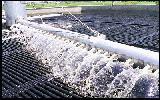
Characteristics of the "Ideal" Packing...
Since the heart of any biofilter is the packing or filter media, it is useful to describe the characteristics of the ideal
or perfect packing. In practice, some characteristics may be mutually exclusive and it may be necessary to trade off one
feature for another. The following list contains most of the pertinent features of a good biofiltration media.
1. High specific surface area : Specific surface area is the measure of how much biologically active area is
contained in a given volume. Typical units of measurement are square feet per cubic foot or square meters per cubic meter.
Specific surface areas vary widely but generally speaking, most packings will fall between 30 and 250 ft2 /
ft3 or 100 and 820 m2 / m3. Specific surface area is often referred to as the "packing
density". It is important to distinguish between total claimed surface area and surface area that is available as a substrate
for biological growth. Surface area that is contained in very fine crevices or pores may not always be available to living
organisms. As a biofilter matures, the biomass of bacteria steadily increases and the layer of bacteria that covers all
available surfaces becomes thicker. Since the organisms inside the layer can only receive food and oxygen by diffusion,
they receive less and less food and oxygen as the layer grows thicker. Generally speaking, only the outermost layer of
bacteria will be operating at peak efficiency.
If the layer of bacteria becomes thick enough, the inside of the layer may become anaerobic. When this happens, the layer
will lose adhesion to the substrate and can be sloughed off. If the dead bacteria is contained in a small crevice, it can
not be sloughed off and it will be retained within the biofilter. This can add to the overall BOD and ammonia load on the
biofilter. The total surface area available for bacterial growth is a good predictor of the capacity of the biofilter to
convert ammonia. The specific surface area is an important variable that influences the cost of the biofilter vessel and
support mechanisms. If packing A has twice as much surface area per unit volume as packing B then packing B will need a
vessel twice as large to accomplish the same task as packing A. From an economic standpoint it makes sense to use the
smallest vessel possible to accomplish a given task. Provided there are no other overriding factors, using a packing with
most surface area per unit volume will allow the vessel costs to be minimized.
2. High void fraction : Void fraction is the percentage of open space or volume in the packing. To phrase it another
way, void fraction is the space not occupied by the packing itself. Void fractions vary from 15% to 98%. High void fractions
allow free and unrestricted flow of water or air and water. A modern packing for aquaculture applications should have a void
fraction of 90% or greater.
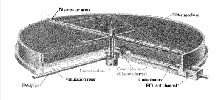
3. Large free (or clear) passage diameter : The best way to understand free passage diameter is to imagine a marble
or ball bearing being dropped through the packing. The size of the largest ball that will pass through the packing is the
free passage diameter.
4. Resistance to plugging or clogging : This parameter is very important but difficult to quantify. Plugging or
clogging of a filter can happen through mechanical trapping of particles in the same way a screen or other particulate
filter works. Plugging can also result from the growth of the biomass and bridging across the spaces within the packing.
Plugging tendency for various packings can be predicted or compared by looking at the void fraction and free passage diameter.
The free passage diameter is the more important variable. Plugging is a very serious problem for biofilters. At best it is a
continuous maintenance problem and at worst it completely destroys the ability of the filter to perform according to design.
Another cause of plugging is non uniformity in packing density. If some areas of the bed are packed denser than others, it
can lead to partial plugging. The high density areas of the filter bed can become plugged and inoperable while the rest of
the bed experiences channeling or localized high flow regions. This can lead to major decreases in filter performance.
Some biofilter systems are designed to accommodate plugging. The filter is operated until performance goes below acceptable
levels and then the bed is cleaned. This can lead to cyclical water quality problems with resultant stress on the fish.
The correct solution is to use a conservative design with a packing that is resistant to plugging for the operating life
of the filter. On the other hand it may not be possible to accommodate a packing that is open enough to insure that it will
never plug. If space is limited it may be necessary to choose a packing that has a very high specific surface area. In this
case it would be wise to use a packing that will be resistant to plugging for at least the amount of time it takes to bring
the crop to marketable size. The packing should be of the type that can be easily removed, cleaned and replaced with a minimum
of effort and labor. Another option is to have a packing that can be removed in sections. A small part of the packing can be
removed and replaced with a spare section while the plugged section is cleaned. If only a small section of the overall system
is removed, the disruptive effect on the whole system will be small. A removable packing is also convenient if one desires
to clean and sterilize the system between crops.
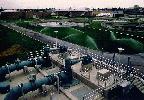
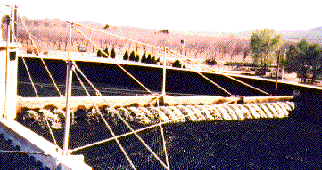
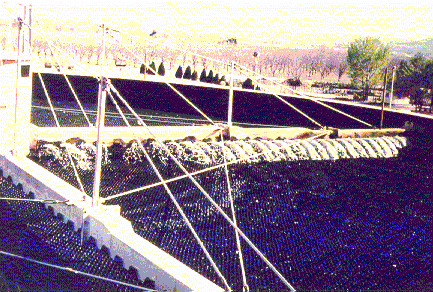
5. Inert material of construction : Wood, paper or other biologically degradable materials are not suitable for
biological filters. Similarly, metals such as steel, aluminum or copper are not usable because they corrode and will
inhibit biological growth. Virtually all commercial available biofiltration packings are non-corrosive, resistant to rot
or decay and generally impervious to chemical attack. However, some plastic packings are susceptible to attack from ultraviolet
radiation. Unprotected plastics that are exposed to sunlight rapidly become brittle. This phenomenon is familiar to anyone
who has left a milk jug outside for a couple months. This problem is entirely preventable through the use of UV inhibitors
that can be incorporated into the plastic. UV protection should be incorporated in any plastic biofiltration packing.
6. Low cost per unit surface area : As we noted above, a biofilter is nothing more than a given amount of surface area
that provides space for bacteria to grow. All things being equal, it makes sense to use the packing with the lowest cost per
unit surface area.
7. Good mechanical strength : One of the features of better biofiltration packings is good mechanical strength. In a
large filter, it is very desirable that the media be able to safely support the weight of one or more workers. Aside from
supporting maintenance traffic, good mechanical strength means better dimensional stability, reduced vessel support requirements
and longer life.
8. Light weight : In addition to freight costs, the weight of a packing can affect costs for other parts of the
system. Heavier packings typically require stronger and more expensive supports and vessels. If the packing or the whole
biofilter must be moved it helps if the media is light weight.
9. Flexible in overall shape : Since biofilter vessels come in all shapes and sizes, the packing should fit into any
shape vessel.
10. Ease of maintenance : A good packing should have little or no maintenance requirements. If maintenance is required
due to plugging or the need to sterilize the system between crops, the packing should be easily moved with a minimum of labor
and specialized equipment. The ability to quickly and easily clean the packing can be important.
11. Low energy consumption : While biofilters do not consume energy directly, their overall design determines the
pump head required to move water through them. Keeping the bacteria supplied with oxygen also requires energy. As biofilters
become more sophisticated and the aquaculture industry becomes more competitive, energy costs will be a major factor in overall
profitability. The biofilter that gets the job done with a minimum of labor and energy consumption will eventually become the
industry standard.
12. Light Attenuation : Nitrifying bacteria are sensitive to light. The packing should be opaque and the shape
should prevent light from penetrating into the interior of the packing.
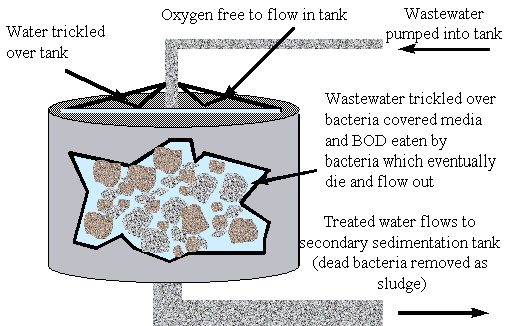
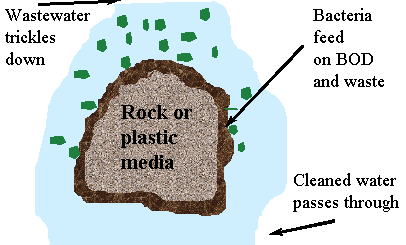
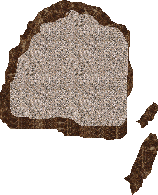 The "ideal" packing provides the low cost solution to our biofiltration needs because it : ...
(a) Gives use the most surface area for the lowest price, (b) Gives us the lowest cost vessel because of high specific
surface area (high packing density), low weight, high mechanical strength and the ability to conform to any vessel shape,
(c) Keeps maintenance costs low due to resistance to plugging and (d) Keeps pumping and other energy costs low due to
flexibility of design.
Types of Packings...
1. Rock and Gravel : Various sizes of gravel and rocks have been used since the nineteenth century in biofilters
for various applications. They can be used in both submerged filters and trickling filters. They are still used for a
variety of applications including aquariums, aquaculture and municipal sewage treatment plants. Earthen materials are
readily available, inexpensive and can have relatively high specific surface areas. Rocks and gravel are typically very
inert and durable with excellent mechanical strength. The main disadvantage to gravel type filters is their very low void
fraction. As a natural consequence of the low void fraction, these types of filters tend to plug rapidly. In order to avoid
plugging, the amount of space between the pieces of gravel must be relatively large. In general, the free passage diameter
is directly related to gravel size. Unfortunately, the specific surface area is inversely related to gravel size. If we use
a size of gravel with openings large enough to avoid plugging, the specific surface area would be too low. With low specific
surface areas, the size of the tank required to hold the packing becomes too large.
The "ideal" packing provides the low cost solution to our biofiltration needs because it : ...
(a) Gives use the most surface area for the lowest price, (b) Gives us the lowest cost vessel because of high specific
surface area (high packing density), low weight, high mechanical strength and the ability to conform to any vessel shape,
(c) Keeps maintenance costs low due to resistance to plugging and (d) Keeps pumping and other energy costs low due to
flexibility of design.
Types of Packings...
1. Rock and Gravel : Various sizes of gravel and rocks have been used since the nineteenth century in biofilters
for various applications. They can be used in both submerged filters and trickling filters. They are still used for a
variety of applications including aquariums, aquaculture and municipal sewage treatment plants. Earthen materials are
readily available, inexpensive and can have relatively high specific surface areas. Rocks and gravel are typically very
inert and durable with excellent mechanical strength. The main disadvantage to gravel type filters is their very low void
fraction. As a natural consequence of the low void fraction, these types of filters tend to plug rapidly. In order to avoid
plugging, the amount of space between the pieces of gravel must be relatively large. In general, the free passage diameter
is directly related to gravel size. Unfortunately, the specific surface area is inversely related to gravel size. If we use
a size of gravel with openings large enough to avoid plugging, the specific surface area would be too low. With low specific
surface areas, the size of the tank required to hold the packing becomes too large.
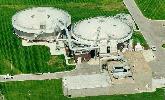
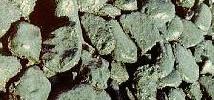
There have been numerous attempts to overcome the drawbacks of gravel packed filters. One method is to use a substrate that
increases the surface area available without changing the overall size of the piece of gravel. This is one of the concepts
behind pumice rock, activated charcoal and micro porous ceramic materials. The claimed surface area for these material is
often very high. The problem lies with the long term operation of these types of packings. Typically, the bacteria growing
on the outer surface of the packing will prevent sufficient nutrients and oxygen from diffusing into the inner pores of the
material. While these packings have large amounts of surface area, only a small fraction of the surface area is usable for
the aerobic bacteria. Another major drawback of gravel is weight. Vessels and under drain systems must be strong enough to
support the gravel. Also, gravel is a relatively permanent filter. Once installed in a given location it is very difficult
to move. In general, the high maintenance costs and high capital costs of the vessels for gravel biofilters makes them
unsuitable for modern commercial aquaculture.
2. Fiber Mesh Pads : Various types of mesh pads are in use today as biofilters. These pads use thin fibers similar
to air conditioning filters but are formed into heavier and thicker pads. They can act as both a physical filter and a
biological filter. They are light in weight and have more surface area per unit volume than any other type of packing.
Unfortunately, fiber mesh pads suffer from the same major drawback as gravel filters. They have very small free passage
diameters and they tend to rapidly plug and lose effectiveness under most circumstances. This tendency to plug is further
complicated by the difficulty of cleaning and regenerating the pads. Typically, fiber mesh pads require a large amount of
labor to be cleaned. Another drawback to the fiber mesh type pad is the difficulty of installing the large quantities of pad
needed for a production system. The pads need extensive supports to keep them oriented in the water flow correctly. Typically,
there are very specific requirements on how mesh pads can be used.
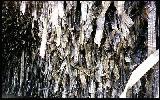
3. Brillo Pads : A packing type similar to the mesh pad is the "ribbon bundle" or "brillo pad" type packing. These
packings are light in weight and offer relatively large amounts of surface area at a low cost. While the ribbons are not
as closely spaced as the fibers in a fiber mesh pad, they still suffer from some of the same drawbacks as the mesh pads.
One of the notable drawbacks to brillo pads is their very poor mechanical strength. It is not possible to stack these
packings without compressing the bottom layers. As the bottom layers are compressed, they restrict the flow and become
easily plugged. Both "brillo pad" and mesh pads have been successful in small aquarium applications but scaling them up to
aquaculture production applications is difficult and uneconomical.
4. Random or Dumped Packings : These packings have been imported and adapted from packings used in the chemical industry.
There are literally dozens of different types of injection molded plastic shapes that are available in a wide variety of
specific surface areas. These packings are "randomly dumped" into vessels, hence the name. Typically, these packings have
a good void fraction and relatively high resistance to plugging compared to mesh pads or gravel beds. Since each piece of
packing is small, random dumped packings readily conform to any shape tank or vessel. Here are a couple typical types of
injection molded packings. Random packings must be installed over a grid or screen type support. They must be contained
because they have no intrinsic structural strength. In general, random packings have poor mechanical strength. One cannot
walk on top of random dumped packings without crushing or compacting the filter bed. Although random packings are relatively
light weight they are difficult to remove from a large vessel once they are installed. This is because the packings must be
scooped or shoveled out of the vessel. Any cleaning that is required must usually be done in place. Another disadvantage
of random packings is that their installation can be tricky. If the bed is not installed carefully, wide variances can result
in the density of the packing throughout the bed. In addition, a bed of random packings will tend to settle and compact over
time.

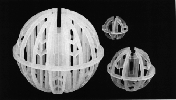
Another disadvantage of both gravel filters and random packings is the inability of the operator to determine what is happening in the interior of the biofilter bed. It is very difficult to shift enough material to see what is happening throughout the bed. The visible top part of the bed may be operating normally while the bottom of the bed is plugged and not operating correctly. Random packings are available in stainless steel, ceramic, porcelain and various engineering thermoplastics. Most packings for aquaculture are injection molded from PP (polypropylene) or HDPE (high density polyethylene). PP and HDPE are excellent polymers with high heat resistance and excellent chemical resistance.
Unfortunately, many PP and HDPE compounds used to mold packings do not incorporate sufficient ultraviolet inhibitors to protect the packings from direct sunlight. While random dumped packings are relatively modern biofilter packings, one of their major drawbacks is cost. Injection molding is an expensive way to create surface area. Dumped packings are best used
in small systems where their high cost is not a factor. They are easy to use in small cylindrical vessels where they can
fill the vessel with no special cutting or waste of material.
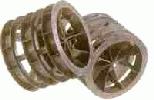
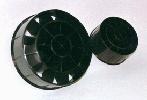
5. Structured Packings : Structured packings are widely used for many applications other than aquaculture biofilters.
They have virtually all of the characteristics that one looks for in the "ideal" packing. Structured packings have been used
in biofilter applications for over 25 years. In the municipal and industrial wastewater treatment fields, they are the packing of choice. Structured packings are typically constructed of vacuum formed sheets of PVC (polyvinyl chloride). This method of construction allows structured packings to be produced for a much lower cost per unit surface area than injection molded packings. PVC is a relatively low cost resin with much better mechanical properties than PP or HDPE. Continuos
vacuum forming is a high speed automated process that can efficiently produce large amounts of material.

The sheets of PVC are welded or glued together to form rectangular blocks. Some packings have internal "tubes" that only
allow flow along one axis of the block. Other types of structured packings known as cross corrugated packings allow flow
along 2 axis of the block. Most structured packings used in aquaculture are of the cross corrugated type. Structured packings
come in a wide range of specific surface areas (SSA) or densities. The density is primarily controlled by the sheet spacing.
The highest practical density for aquaculture applications is about 120 ft2 / ft3 which is a sheet spacing of about 1/4 in. The lowest specific surface area typically used for aquaculture is 48 ft2 / ft3 with a sheet spacing of 3/4 in. The void fraction changes very little with sheet spacing. The highest density structured packing has a void fraction of about 95 % while low SSA packings are usually about 98 % void fraction. For both random packings and structured packings, void fraction is usually not a good predictor of plugging potential. It is more important to look at free passage diameter.
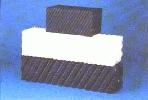
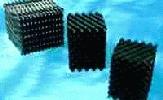
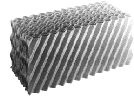
One of the big advantages of structured packings is their great mechanical strength combined with light weight. An intermediate packing with a SSA of 68 ft2 / ft3 will weigh about 2.5 lbs / ft3. However,
it will have a crush strength of over 2,000 lbs / ft2 of plan area. Unlike any other type of packing, structured packings can span distances of up to 10 ft. between supports when used in a trickling filter. It is more common however to support them on beams that are 2 to 3 ft on center. Another advantage to structured packings is that they can be used
without any containment vessel in a trickling filter design. Blocks of packing can be stacked in layers over a sump and
water merely distributed over the top. Another important advantage of the structured packings is their ease of installation and removal. Typical block sizes are 12" x 12" x lengths up to 10'. A clean, 10 ft3 block with 680
ft2 of surface area will only weigh about 25 lbs. 10 ft3 of gravel with a similar surface area would weigh over 1000 lbs. While it is beyond the scope of this article to discuss overall biofilter design, structured packings allow the design of filters that operate with the lowest energy costs in terms of water pumping head and aeration compressor pressures.
 "Comparison of Different Filling Media"...
"Comparison of Different Filling Media"...
Note : 1 = Worst, 5 = Best, A = Acceptable
 Click here for "Trickling Filter Ecology"...
Click here for "Trickling Filter Ecology"...
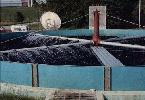
Brief Summary of the Trickling Filter...
General : Trickling filter wastewater treatment systems were once used primarily for secondary biological treatment.
Since typical effluent characteristics do not meet today's strict effluent limitations, many systems have concerted to
activated sludge. Attached growth systems still have application today when coupled with a suspended growth option.
Advantages of TF Systems : (a) simplicity of operation, (b) resistance to shock loads, (c) low sludge yield and (d)
low power requirements.
Disadvantages of TF Systems : (a) relatively low BOD removal (85%), (b) high suspended solids in the effluent (20 -
30 mg/L) and (c) little operational control.
Standard Rate and High Rate Trickling Filter : Classification of trickling filters is usually based on organic and
hydraulic loadings. Standard rate filters see a hydraulic loading of 25 - 100 gpd/ft2 and an organic loading
of 15 - 30 lbs BOD/day/1,000 ft3. Loading greater than this will put the filter into the high rate category.
Generally the higher the loading the lower the treatment (lower BOD removal). The higher the organic loading the faster the
biomass growth to a point. Nitrification usually occurs in the standard rate system.
Synthetic Media : Synthetic media in a trickling filter system results in a greater surface area available for
biological growth per cubic foot of filter volume. Because of the low weight of synthetic media, filters can be built 40
ft and higher. The result is the ability to handle greater loadings.
High Void Ratio : Void ratio refers to the physical openings in the media for water and solids to pass. A higher
void ratio allows for a greater hydraulic loading and makes the media less susceptible to plugging.
Oxygen Transfer and Detention Time : The design of synthetic media (especially crossflow) provides for greater
turbulence at the surface of the media. This greater turbulence promotes oxygen transfer. The greater the surface are per
cubic foot of media, the longer it takes for the water to "trickle" through the filter. Synthetic media with 25
- 75 ft2/ft3 provide long detention times.
Objectives of Trickling Filter Recirculation : (a) reduce strength of filter influent, (b) maintain constant wetting
rate, (c) force sloughing to occur, increase shear forces, (d) dilute toxic wastes, (e) reseed the filter and (f) increase
air flow.
Series and Parallel Flow : Parallel flow of a two-stage trickling filter system provides the greatest surface are
in the first step of treatment. Parallel flow for high hydraulic and/or organic loadings. Series flow buys more treatment
time. Shift to series for nitrification.
Some Basic Calculations...



 "Trickling Filter & Activated Sludge Process - 1"...
"Trickling Filter & Activated Sludge Process - 1"...
 "Trickling Filter & Activated Sludge Process - 2"...
"Trickling Filter & Activated Sludge Process - 2"...
Nitrification in Trickling Filters : Nitrification occurs under the same environmental conditions as activated
sludge treatment systems. Low hydraulic loadings (standard rate), warm temperatures and long detention times (series flow
or synthetic media) promote nitrification. In trickling filter systems, the SBOD must be less than 20 mg/L for nitrification
to occur.
Phosphorus Removal : Some of the soluble phosphorus is removed when the BOD is removed by the biomass. Additional
phosphorus removal would have to take place in a separate tank. Either chemical precipitation or a suspended growth system
with an anaerobic tank would be needed.
SBOD : Soluble BOD is usually the test of choice for operational control of any attached growth treatment system.
To get a true measure of the BOD removal, the particulate material (sloughed biomass) must be removed from the sample. SBOD
measures the dissolved organics that need to be removed by the biomass.
Combination Systems : Combination systems such as TF/SC, TF/AS, and filtration systems are used to clean up the
effluent from the attached growth system. This takes advantage of the trickling filter's capability but still provides
final effluent to meet a 10/10 effluent permit.






















 "Comparison of Different Filling Media"...
"Comparison of Different Filling Media"...
 Click here for "Trickling Filter Ecology"...
Click here for "Trickling Filter Ecology"...




 "Trickling Filter & Activated Sludge Process - 1"...
"Trickling Filter & Activated Sludge Process - 1"...
 "Trickling Filter & Activated Sludge Process - 2"...
"Trickling Filter & Activated Sludge Process - 2"...

